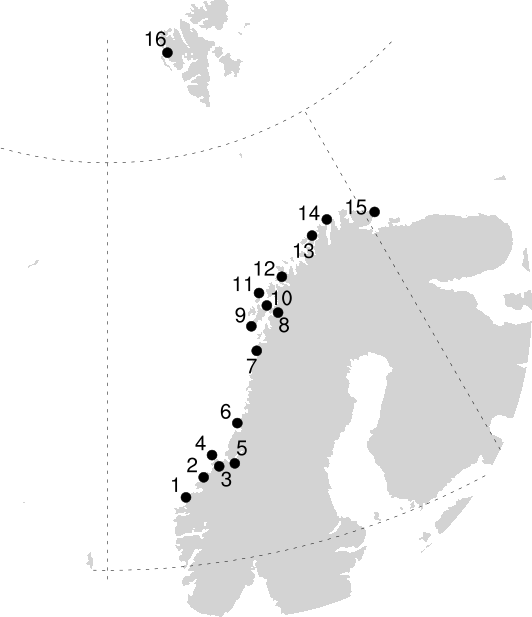Copernicus Marine Service Arctic MFC: Validation of storm surge and tides
Validation based on tide gauge data

|
The validation of the results from the Copernicus Marine Arctic MFC storm surge and tidal model product ARCTIC_ANALYSISFORECAST_PHY_TIDE_002_015 is performed using tide gauge data from product INSITU_ARC_PHYBGCWAV_DISCRETE_MYNRT_013_031 disseminated by Copernicus Marine. Tide gauge data and model results are freely available for registered Copernicus Marine users of marine.copernicus.eu.
Observations from tide gauges are available for a set of tide gauge stations, with a temporal resolution of 10 minutes. Presently, data from 16 stations are available for the Arctic region from the INSITU TAC product. All of these are from tide gauges at the coast of Norway, which unfortunately has the consequence that the validation results can't be taken to represent the entire Arctic region. The positions of the various tide gauge stations are displayed on the map to the left. The Arctic MFC storm surge and tides model is run daily with a forecast period of 10 days. Model results are available with a temporal resolution of 15 minutes on a 3 km stereographic grid projection. For the validation figures results are displayed for observations and forecast lead times of 1 and 8 days. Model results are extracted for the nearest positions in the model grid that corresponds to each tide gauge station. If this is not a wet grid cell with a neighbouring dry cell, the extraction cell is modified accordingly. The Arctic MFC storm surge and tides model is operated and maintained by the Norwegian Meteorological Institute. Model results are available as Copernicus Marine product ARCTIC_ANALYSISFORECAST_PHY_TIDE_002_015. An archive of historical forecasts are available from a thredds server. |